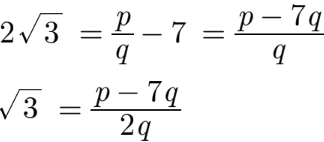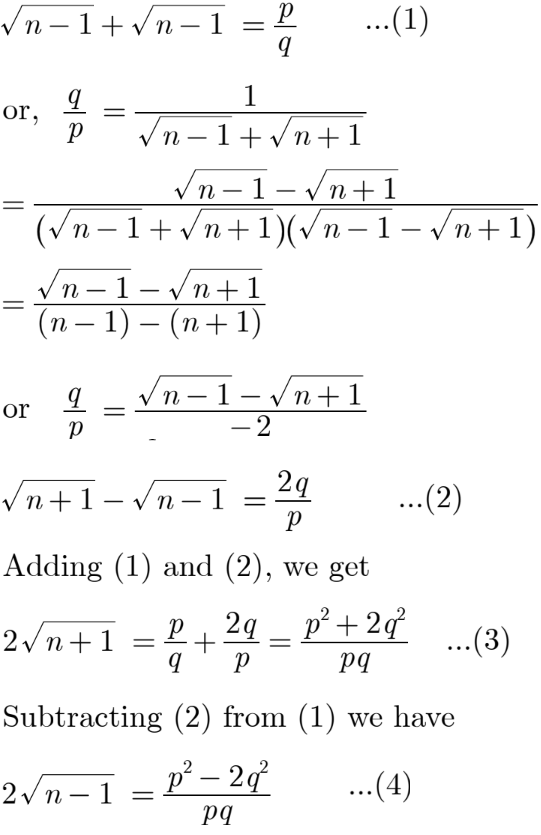LAQ for Chapter 1 Real Numbers Class 10 Math NCERT
Important Questions1
Prove that √3 is an irrational number.
Answer
Assume that √3 is a rational number. Therefore, we can write it in the form of a/b where a and b are co – prime integers and q ≠ 0.Assume that √3 be a rational number then we have
√3 = a/b ,
Where a and b are co – primes and b ≠ 0.
Now a = b√3
Squaring both the sides, we have
a2 = 3b2
Thus 3 is a factor of a2 and in result 3 is also a factor of a.
Let a = 3c where c is some integer, then we have a2 = 9c2
Substituting a2 = 3b2 we have
3b2 = 9c2
b2 = 3c2
Thus 3 is a factor of b2 and in result 3 is also a factor of b.
Thus 3 is a common factor of a and b. But this contradicts the fact that a and b are co – primes. Thus, our assumption that √3 is rational number is wrong.
Hence √3 is irrational.
LAQ
2
Prove that √5 is an irrational number.
Answer
Assume that √5 be a rational number then we have√5 = a/b,
where a and b are co – primes and b ≠ 0.
a = b√5
Squaring both the sides, we have
a2 = 5b2
Thus 5 is a factor of a2 and in result 5 is also a factor of a.
Let a = 5c where c is some integer, then we have
a2 = 25c2
Substituting a2 = 5b2 we have
5b2 = 25c2
b2 = 5c2
Thus 5 is a factor of b2 and in result 5 is also a factor of b.
Thus 5 is a common factor of a and b. But this contradicts the fact that a and b are co – primes. Thus, our assumption that √5 is rational number is wrong.
Hence √5 is irrational.
LAQ
3
Find HCF and LCM of 378, 180 and 420 by prime factorization method. Is HCF × LCM of these numbers equal to the product of the given three numbers?
Answer
Finding prime factor of given number we have,378 = 2 × 33 × 7
180 = 22 × 32 × 5
420 = 22 × 3 × 7 × 5
HCF(378, 180, 420) = 2 × 3 = 6
LCM (378, 180, 420) = 22 × 33 × 5 × 7
= 22 × 33 × 5 × 7 = 3780
HCF × LCM = 6 × 3780 = 22680
Product of given numbers
= 378 × 180 × 420
= 28576800
Hence, HCF × LCM ≠ Product of three numbers.
LAQ
4
State Fundamental theorem of Arithmetic. Find LCM of number 2520 and 10530 by prime factorization by 3.
Answer
The fundamental theorem of arithmetic (FTA), also called the unique factorization theorem or the unique – prime – factorization theorem, states that every integer greater than 1 either is prime itself or is the product of a unique combination of prime numbers.OR
Every composite number can be expressed as the product powers of primes and this factorization is unique.
Finding prime factor of given number we have,
2520 = 20 × 126 = 20 × 6 × 21
= 23 × 32 × 5 × 7
10530 = 30 × 351 = 30 × 9 × 39
= 30 × 9 × 3 × 13
= 2 × 34 × 5 × 13
LCM (2520, 10530) = 23 × 34 × 5 × 7 × 13
= 294840
LAQ
5
Can the number 6n, n being a natural number, end with the digit 5? Give reasons.
Answer
If the number 6n for any n, were to end with the digit five, then it would be divisible by 5. That is, the prime factorization of 6n would contain the prime 5. This is not possible because the only prime in the factorization of 6n = (2 × 3)n are 2 and 3. The uniqueness of the Fundamental Theorem of Arithmetic guarantees that there are no other primes in the factorization of 6n . Since there is no prime factor 5, 6n cannot end with the digit five.
LAQ
6
State Fundamental theorem of Arithmetic. Is it possible that HCF and LCM of two numbers be 24 and540 respectively. Justify your answer.
Answer
Fundamental theorem of Arithmetic: Every integer greater than one ither is prime itself or is the product of prime numbers and that this product is unique. Up to the order of the factors. LCM of two numbers should be exactly divisible by their HCF. In other words LCM is always a multiple of HCF. Since, 24 does not divide 540 two numbers cannot have their HCF as 24 and LCM as 540.HCF = 24
LCM = 540
not an integer.
LAQ
7
For any positive integer n, prove that n3 – n is divisible by 6.
Answer
We have n3 – n = n(n2 – 1)= (n – 1) n(n + 1)
= (n – 1)n(n + 1)
Thus n3 – n is product of three consecutive positive integers.
Since, any positive integers a is of the form 3q, 3q + 1or 3q + 2 for some integer q.
Let a, a+ 1, a + 2 be any three consecutive integers.
Case I: a = 3q
If a = 3q then,
a(a + 1)(a + 2) = 3q(3q + 1)(3q + 2)
Product of two consecutive integers (3q + 1) and (3q + 2) is an even integer, say 2r.
Thus a(a + 1)(a + 2) = 3q(2r)
= 6qr, which is divisible by 6.
Case II: a = 3q + 1
If a = 3q + 1 then
a(a + 1)(a + 2)
= (3q + 1)(3q + 2)(3q + 3)
= (2r)(3)(q + 1)
= 6r(q + 1)
which is divisible by 6.
Case III: a = 3q + 2
If a = 3q + 2 then
a(a + 1)(a + 2)
= (3q + 2)(3q + 3)(3q + 4)
= 3(3q + 2)(q + 1)(3q + 4)
Here (3q + 2) and = 3(3q + 2)(q + 1)(3q + 4)
= multiple of 6 every q
= 6r (say)
which is divisible by 6. Hence, the product of three consecutive integers is divisible by 6 and n3 – n is also divisible by 3.
LAQ
8
Prove that n2 – n is divisible by 2 for every positive integer n.
Answer
We have n2 – n = n(n – 1)Thus n2 – n is product of two consecutive positive integers.
Any positive integer is of the form 2q or 2q + 1, for some integer q.
Case I: n = 2q
If n = 2q we have
n(n – 1) = 2q(2q – 1)
= 2m,
where m = q(2q – 1) which is divisible by 2.
Case II: n = 2q + 1
If n = 2q + 1, we have
n(n – 1) = (2q + 1)(2q + 1 – 1)
= 2q(2q + 1)
= 2m
where m = q(2q + 1) which is divisible by 2.
Hence, n2 – n is divisible by 2 for every positive integer n.
LAQ
9
Prove that √3 is an irrational number. Hence, show that 7 + 2√3 is also an irrational number.
Answer
Assume that √3 be a rational number then we have√3 = a/b , (a, b are co-primes and b ≠ 0)
a = b√3
Squaring both the sides, we have
a2 = 3b2
Thus 3 is a factor of a2 and in result 3 is also a factor of a.
Let a = 3c where c is some integer, then we have a2 = 9c2
Substituting a2 = 9b2 we have
3b2 = 9c2
b2 = 3c2
Thus 3 is a factor of b2 and in result 3 is also a factor of b.
Thus 3 is a common factor of a and b. But this contradicts the fact that a and b are co – primes. Thus, our assumption that √3 is rational number is wrong.
Hence √3 is irrational.
Let us assume that 7 + 2√3 be rational equal to a, then we have
7 + 2√3 = p/q, q ≠ 0 and p and q are co-primes

Here p – 7q and 2q both are integers, hence √3 should be a rational number. But this contradicts the fact that √3 is an irrational number. Hence our assumption is not correct and 7 + 2√3 is irrational.
LAQ
10
Show that there is no positive integer n, for which  is rational.
is rational.
Answer
Let us assume that there is a positive integer n for which
From (3) and (4), we observe that
LAQ